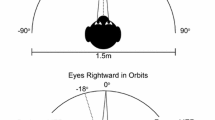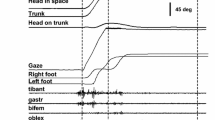Summary
In studies of human eye-head coordinated saccadic gaze shifts, different laboratories have found greatly different magnitudes of head movements for a given amplitude of gaze shift (head movement gain). The present study was conducted to examine why, and to quantify volitional head movements. Fixation/target lights were located at 20° and 40° on either side of a central light. There were two tasks or modes. In the non-aligned mode, gaze fixation (first light) was followed by a gaze step to the target (second light) accurately and quickly. In the head-aligned mode, the head was aligned within 3° of the first fixation light (i.e., initial starting position) before the step sequence began. In both non-aligned and head-aligned modes, subject instructions pertaining to the second target light concerned only gaze; there was no requisite head position. The head movement propensity of nine subjects was ranked according to the mean gain (head/target amplitude) of two 40° jumps (0–40° and — 20 to + 20°) in the non-aligned mode. This ranking method clearly identified extreme head-movers and non-movers. The moderate movers were further characterized by three additional criteria, derived by comparing the gains in different jumps, which varied in starting position and amplitude. First, when the two 40° jumps were compared, typically the gain of non-movers was less in the symmetric jump (- 20 to + 20°) with the gain of the head-movers was greater in the symmetric jump. Second, in the head-aligned mode the gain of non-movers progressively increased when the starting position was progressively moved eccentrically, whereas the gain of head-movers increased only slightly, if at all. Third, when the gains of two symmetric (40° and 80°) jumps were compared, the head-movers consistently had opposite trends from non-movers. These three comparative criteria and the initial criterion together define head movement propensity. To explain the above observations, three effects are proposed. First, a “midline-attraction” effect causes resistance to movement away from the midline in non-movers and an increase in movement amplitude if the jump starts eccentrically. Second, a “resetting” effect occurs when the eccentricity of the jump is varied; the stopping position is reset closer to the target. Third, an “awareness/arousal” effect increases the gain in the head-aligned mode due to the intrinsic nature of the alignment procedure. Minor physical movement impediments were added to the recording apparatus; these impediments essentially had no effect on head movement gain, and only slightly altered peak head velocity of large movements. Thus, nonphysical variations in eliciting gaze shifts likely determine gain in different laboratories; gain is reliable if measured on a relative scale among similarly tested subjects. Individuals have an innate behavioral propensity to move their head; this may in part reflect the individual's method of constructing stable coordinate systems relating internal to external reference frames, with head-movers initially choosing extrinsic spatial or earth-fixed coordinates and non-movers choosing intrinsic coordinates.
Similar content being viewed by others
References
Afanador AJ, Aitsebaomo AP (1982) The range of eye movements through progressive mulitfocals. Optomet Monogr 73: 82–88
Bahill AT, Clark MR, Stark L (1975) Glissades — eye movements generated by mismatched components of the saccadic motoneuronal control signal. Math Biosci 26: 303–318
Bard C, Fleury M, Paillard J (1992) Head orienting and aiming accuracy. In: Berthoz A, Graff W, Vidal P-P (eds) Head-neck sensory-motor system. Oxford University Press, Oxford, pp 582–586
Barnes GR (1979) Vestibulo-ocular function during co-ordinated head and eye movements to acquire visual targets. J Physiol (Lond) 287: 127–147
Becker W (1989) Metrics. In: Wurtz R, Goldberg M (eds) The neurobiology of saccadic eye movements. Elsevier, Amsterdam New York, pp 13–67
Bizzi E, Kalil RE, Morasso P (1972) Central programming and peripheral feedback during eye-head coordination in monkeys. Bibl Ophthal 82: 220–232
Delreux V, Abeele SV, Lefevre P, Roucoux A (1991) Eye-head co-ordination: influence of eye position on the control of head movement amplitude. In: Paillard J (eds) Brain and space. Oxford University Press, Oxford pp 38–48
Droulez J, Berthoz A (1991) A neural network model of sensoritopic maps with predictive short-term memory properties. Proc Natl Acad Sci USA 88: 9653–9657
Fuller JH (1981) Eye and head movements during vestibular stimulation in the alert rabbit. Brain Res 205: 363–381
Fuller JH (1992a) Comparison of head movement strategies among mammals. In: Berthoz A, Graff W, Vidal P-P (eds) Head-neck sensory-motor system. Oxford University Press, Oxford pp 101–112
Fuller JH (1992b) Single vestibular unit recording in alert cat during active and passive head movements. In: Berthoz A, Graff W, Vidal P-P (eds) Head-neck sensory-motor system. Oxford University Press, Oxford, pp 279–288
Goldberg ME, Wurtz RH (1972) Activity of superior colliculus in behaving monkey. I. Visual receptive fields of single neurons. J Neurophysiol 35: 542–559
Gresty MA (1974) Coordination of head and eye movements to fixate continuous and intermittent targets. Vision Res 14: 395–403
Guitton D, Volle M (1987) Gaze control in humans: eye head coordination during orienting movements to targets within and beyond the oculomotor range. J Neurophysiol 58: 427–459
Jampel RS, Shi DX (1992) The primary position of the eyes, the resetting Saccade, and the transverse visual head plane. Invest. Ophthalmol. Vis. Sci. 33: 2501–2510
Pozzo T, Berthoz A, Lefort L (1992) Head Kinematics during complex movements. In: Head-neck sensory-motor system. Berthoz A, Graff W, Vidal P-P (eds) Oxford University Press, Oxford, pp 587–590
Seagraves M, Goldberg M (1992) Properties of eye and head movements evoked by electrical stimulation of the monkey superior colliculus. In: Head-neck sensory-motor system. Berthoz A, Graff W, Vidal P-P (eds) Oxford University Press, Oxford, pp 292–295
Tomlinson D, Bahara PS (1986) Combined eye-head gaze shifts in the primate. I. Metrics. J Neurophysiol 56: 1542–1557
Viirre E, Tweed D, Milner K, Vilis T (1986) A reexamination of the gain of the vestibuloocular reflex. J Neurophysiol 56: 439–450
Zangemeister WH, Stark L (1981) Active head rotations and eyehead coordination. Ann NY Acad Sci 374: 540–559
Author information
Authors and Affiliations
Rights and permissions
About this article
Cite this article
Fuller, J.H. Head movement propensity. Exp Brain Res 92, 152–164 (1992). https://doi.org/10.1007/BF00230391
Received:
Accepted:
Issue Date:
DOI: https://doi.org/10.1007/BF00230391




